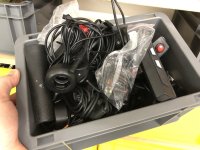izeman said:
Disassembles a throttle (well two of them to be sure), connected the throttle output to the ebrake input, but it didn't work as expected.
The throttle outputs 2.4-3.8V from 0-100% opened. But the CA seems to expect a much smaller value then 2.4V as closed. I could now add some resistor network to bring down this voltage to a lower voltage, but I'm not sure if this is the best way to do it.
AFAIK the CA only accepts a digital (on-off) signal for the ebrake input, basically shorting the ebrake signal in to ground.
https://www.ebikes.ca/product-info/cycle-analyst-3.html
Ebrakes: A digital input for ebrake sensors to plug in directly to the CA3, without needing to run another set of cables all the way down the bike to the controller.
The bit you quoted in another post about the CA and controllers' ranges is only referring to the *throttle* voltage. What happens when supporting a controller that accepts that kind of input is that when the ebrake input is engaged, the CA then changes throttle modes so that adjusting the throttle then converts the throttles output to a range *below* 0.8v, instead of above it, so that a controller that uses throttle input for proportional regen control in that range will respond appropriately.
I'm not sure there is any way to directly use an analog ebrake lever with the CA.
However...you *could* setup the ebrake lever so it's output range is the same as the throttle's--about 0.8-1.4v for it's lowest outptu voltate, when brakes are off. Then about 3.5-4v for it's highest output voltage, when the lever is pulled as far as you would want to have to pull it for max braking.
Then add a switch (direct, relay, electronic, etc) that when you begin to pull the brake lever disconnects the throttle's signal wire from the CA's throttle input and connects the brake lever's signal wire there. (or parallel the signal wires, and just switch the power wire from one hall to the other).
Then the brake lever would do the controlling of the below-0.8v-range, and the throttle would do the controlling above that, so you don't have to get used to using the throttle to control your braking power, for controllers that would be setup for thta (like the Phaserunner, etc).
If the controller doesn't support controlling proportional regen via the throttle input, then you can connect your analog output brake lever directly to the controller, but still have an ebrake switch on it that goes to the CA's ebrake input, to tell the CA to stop sending a throttle signal when braking.


